Ghost Story, the glossy, high-end 1981 horror flick from Universal and director John Irvin, makes its Blu-ray debut thanks to Shout! Factory’s Scream Factory line.
By Paul Mavis
Based quite loosely on Peter Straub’s spellbinding epic novel, Ghost Story proved to be a financial and critical failure when first released. Horror completists who can stand the too-deliberate pacing, big swings in tone, and clunky editing, should be compensated by newcomer Alice Krige’s sexy, scary turn and some standout visual work by masters Albert Whitlock, Jack Cardiff, and Dick Smith—all anchored by the incongruous, do-a-double-take sight of four legendary Hollywood performers (Fred Astaire, Melvyn Douglas, Douglas Fairbanks, Jr., and John Houseman) headlining, of all things, an R-rated 1980s shocker.
Click to purchase Ghost Story at Amazon.Your purchase helps pay the bills at this website!

Something is causing horrific nightmares for the town elders of snowy New England hamlet Milburn, Vermont. Crusty lawyer Sears James (John Houseman, Rollerball, The Fog) sits up nights in his den drinking, avoiding sleep. Lifelong friends and fellow ghost story-telling members of the self-proclaimed “Chowder Society,” however, aren’t so lucky. Retired physician Dr. John Jaffrey (Melvyn Douglas, The Tenant, The Changeling), businessman Ricky Hawthorne (Fred Astaire, The Towering Inferno), and Milburn’s mayor Edward Charles Wanderley (Douglas Fairbanks, Jr., The Prisoner of Zenda, Sinbad the Sailor), all cry out in their sleep as an unseen terror haunts their dreams.
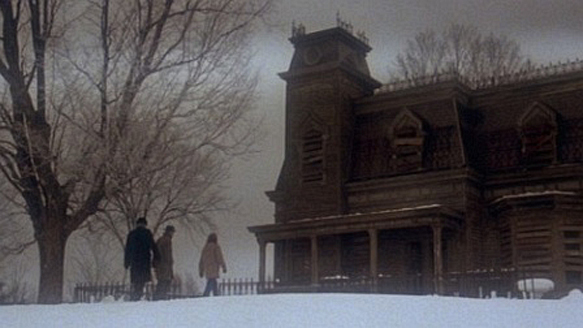
Edward’s son, Manhattan businessman David Wanderley (Craig Wasson, Body Double, A Nightmare on Elm Street 3: Dream Warriors) could only wish his latest relationship was a dream; following an afternoon of lovemaking with his enigmatic, coldly erotic fiancé Alma Mobley (Alice Krige, Sleepwalkers, Silent Hill), her true form is revealed to him. She’s a…rotting corpse, and David recoils in horror, falling backwards out the window of his high-rise apartment, smashing to the ground. David’s twin brother Don (Wasson, in a dual role), a failed college teacher, returns to his hometown of Milburn for his brother’s funeral, and to inform his father that David’s death was not an accident. Don had Alma first as a fiancé…and her creepy, otherworldly demeanor ultimately proved too much for leery Don (when she silkily intoned, “I shall see the life drain out of you,” while staring off into space, the penny finally dropped for Don). When Edward Wanderley falls to his death in an eerily similar manner to David’s—Edward sees Alma’s rotting corpse and immediately takes a header into the frozen river—Don knows that the “Chowder Society” is hiding something, something awful from their long-gone youth. And that something is Alma.
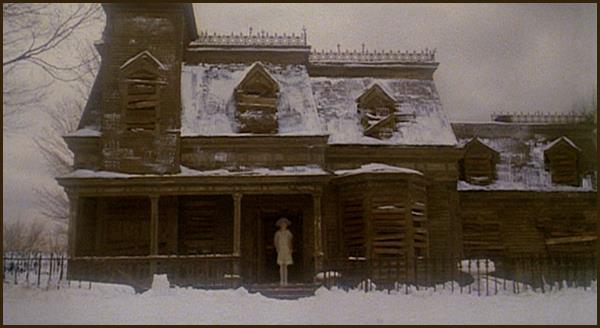
There was quite a bit of initial buzz over Ghost Story’s production, particularly when the press learned that Universal paid $1 million for the movie rights (an incredible sum back then for a horror novel). Author Peter Straub’s 1979 novel had sold big in hardcover and paperback, while garnering critical raves rarely extended to modern examples of the genre (in my opinion, it’s far superior to anything rival Stephen King ever wrote). Horror was doing gangbusters at the box office, ever since exploitation takes like The Omen, Halloween, Carrie, and Friday the 13th cemented the audience trend begun with earlier blockbusters Rosemary’s Baby and The Exorcist.
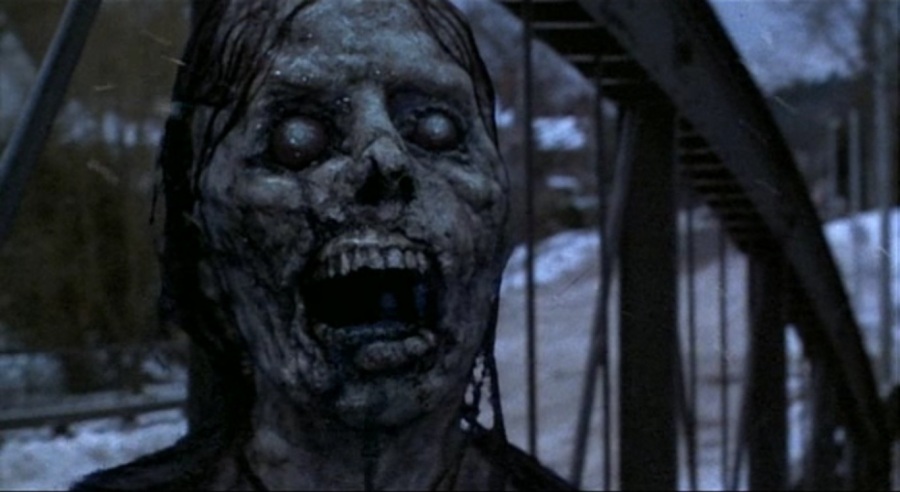
Ghost Story was to be Universal’s prestige Christmas release for 1981, and a nice-sized budget for a horror movie back then ($13 million) was allocated. Burt Weissbourd, a producer with little horror experience (1977’s Haunts), chose scripter Lawrence D. Cohen (De Palma’s Carrie) to somehow tackle the daunting task of paring down Straub’s epic-sized narrative. The directing reins were handed to Britisher John Irvin (Raw Deal, TV’s Tinker, Tailor, Soldier, Spy), who had just delivered the as-yet-released The Dogs of War, his first American movie (there were reports that some better known American A-list directors expressed interest in the project but were rebuffed).
Problems, however, cropped up almost immediately in pre-production. According to an interview with scripter Cohen included on this disc, too much of Straub’s story was being jettisoned for Cohen’s liking by a studio in search of a minus-two hour runtime (no doubt to facilitate more screenings per day). A story that ideally would have been better suited for a miniseries was getting chopped down to size…and increasingly for the worse. More headaches occurred during the January, 1981 location shoot in Woodstock, Vermont; namely: no snow on the ground for what needed to be a blizzard-blanketed story. While more money was allocated for renting giant snowmaking machines at nearby Lake Placid, hurry-up work was being done by Dick Smith (who was contracted rather late in the production stage) for his ghost prosthetics, and by special visual effects whiz Albert Whitlock, who had to come up with additional painted mattes to fill in snow for the bare backgrounds.

Once production wrapped, director Irvin began assembling the picture, and in the process began throwing out major special effects scenes (a poltergeist attack on a farm house was one of the more costly sequences, while a now-notorious naked “faceless apparition” version of the Krige ghost from Smith was cut out and replaced). Test screenings and audience previews just months before the December hard opening were not encouraging, so mad dash reshoots (including an alternate ending) and cobbled-together new special effects were laden onto the increasingly compromised picture.
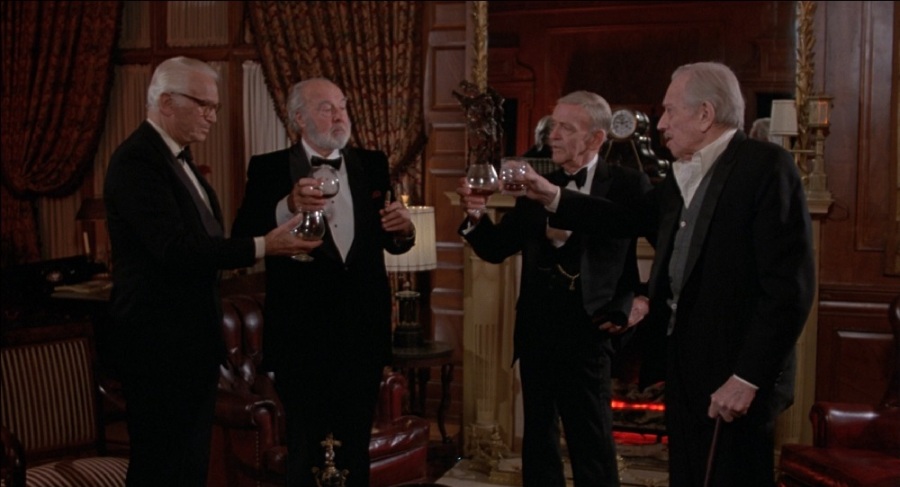
Hobbled by a lack of screens in the crowded Christmas market, Ghost Story premiered on December 18th, 1981, coming in an unencouraging sixth for the weekend with a light $2.1 million take (the Belushi/Aykroyd comedy Neighbors and Burt Reynolds’ Sharky’s Machine were numbers one and two that weekend…but they each had over 1300 screens; Ghost Story had a paltry 548). Despite a general ho-hum critical reception, Ghost Story went on to earn a seemingly respectable $23 million for its first-run haul (the equivalent of a $80+ million gross today). However, with only about half of that returned as rentals to Universal, and with prints and publicity factored in, too, Ghost Story wound up a substantial financial loser for the studio.
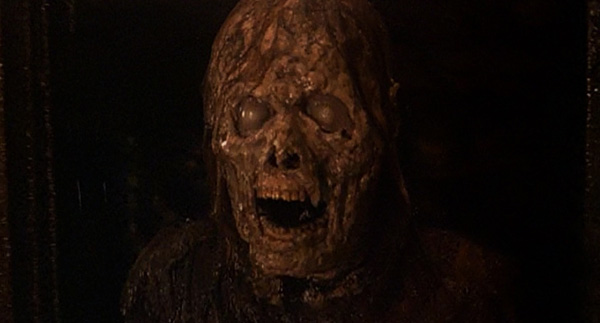
Considering its famed literary pedigree , its classy production, its starry cast, and its underdog status with then-critics and audiences, there’s a natural tendency for movie lovers to want to elevate Ghost Story into some kind of neglected classic that somehow “needs” to be re-discovered. Unfortunately, Ghost Story’s big problems are just as apparent now as they were 36 years ago.
Certainly it would be easy to dismiss it simply on the grounds that it doesn’t adequately capture Straub’s vision, regardless of its length. Naturally, if a two-hour movie was required, then subplots and characters necessarily had to be excised from Straub’s massive tome. Gone is shapeshifter Alma/Eva’s eternal status (in the movie she’s merely the vengeful ghost/rotting corpse of an all-too corporeal young beauty accidentally killed one long-ago summer); gone is the notion of Milburn decaying from the inside while externally threatened by Alma/Eva because of the hidden sin of the “Chowder Society;” and gone are whole reams of characters and subplots that made the novel so scary (the movie’s most conventionally “scary” character—Alma/Eva’s evil minion Gregory Bate, played by Miguel Fernandes—makes zero sense here in Cohen’s truncated script…nor is he particularly frightening as directed by Irvin). To be sure these were vital elements of Straub’s novel, but a savvy director still had the bones to make a scary thriller worthy of its literary inspiration.
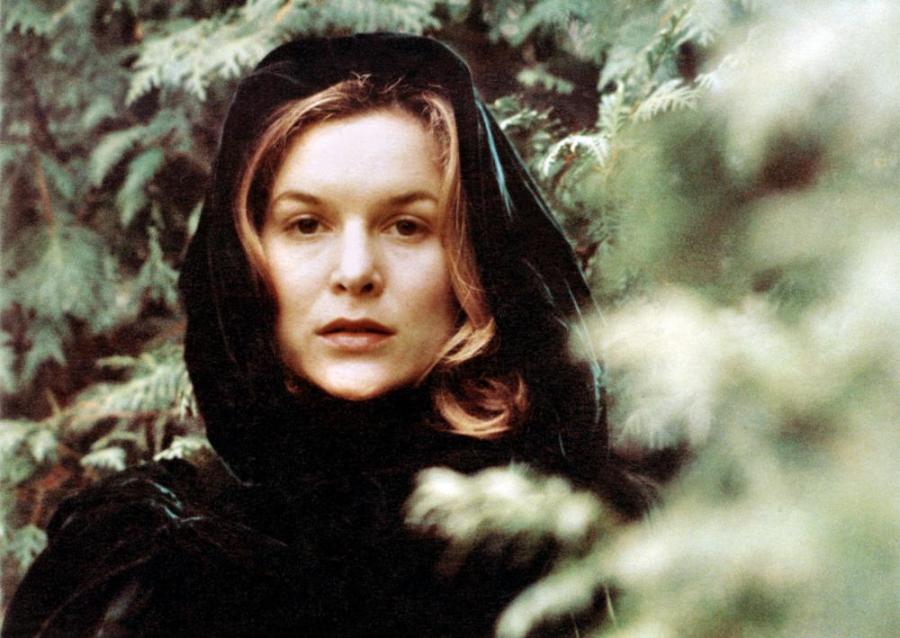
Ghost Story’s surprisingly bland, realistic tone, however, is all wrong for getting across Straub’s almost baroque, hallucinatory, time-shifting reinvention of classic American horror in the vein of Nathaniel Hawthorne and Ambrose Bierce. In screenwriter Lawrence D. Cohen’s interview included on this disc, he’s very careful in suggesting Britisher John Irvin—with Irvin’s background in documentaries and his penchant for dour realism in his actioners—was the wrong choice to helm Ghost Story, with Irvin’s grounding of the horror elements in more prosaic elegy ultimately coming out as a disservice to Straub’s wild flights of surreal fancy. In John Irvin’s commentary track included on this disc, the director is quite open about wanting to have shot Ghost Story as more of a suggestive, relatively sedate, cerebral horror mystery, rather than as a R-rated shocker with Dick Smith mannequins popping up, oozing with gore.
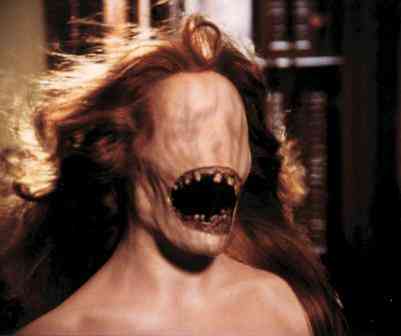
And yet, Irvin acknowledges that he knuckled under with the studio and began altering the movie, taking out more subtle scares and putting different, cruder ones in, and in the process perhaps hollowing out a movie that was becoming deeply schizophrenic in its aims. Irvin states on the commentary track that Ghost Story is about hypocrisy in a small town, and men fearing and ultimately hating women, but very little of that comes through in the movie. We never really believe or feel that Milburn is a town because Irvin stays largely indoors, and mainly shoots just the principal leads. You don’t need to ask, “Doesn’t anybody else live in Milburn?” because Irvin rarely hits the streets; reportedly, he jettisoned many Whitlock mattes that helped visually establish the town (who the hell would reject a Whitlock matte?).
Worse yet, the pacing of Ghost Story is frustratingly glacial. In an interview included on this disc, producer Burt Weissbourd alludes to concerns from the studio and test audiences with the internal pacing of scenes and the overall slow movement of the picture. Champions of Ghost Story claim audiences didn’t like it back in 1981 because they wanted the cheap, crude splatter of contemporary titles like Friday the 13th: Part II. Perhaps…although that argument always smacks of a disdainful elitism all too common in American critics (audiences want all kinds of things. They can want subtlety on a Monday and pulp on a Friday).
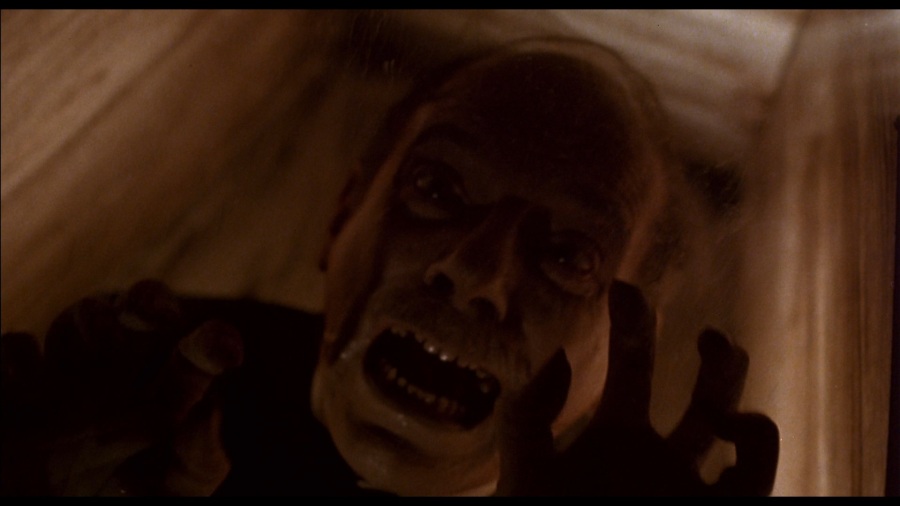
However, Irvin’s attempt at “classic” refined horror in the vein of Jack Clayton’s The Innocents or Robert Wise’s The Haunting fails because a horror movie still must scare you at some point…not lull you into a continuous lugubrious funk brought on by pokey scenes and pallid structuring. Why didn’t he and Cohen stick with the “Chowder Society” through the whole movie? The moviemakers were given the astonishing good fortune to have four bona fide legends—Fred Astaire, Douglas Fairbanks, Jr., Melvyn Douglas, and John Houseman, for god’s sake—appearing in their R-rated horror pic…and yet they’re barely used here, with their sterling professionalism almost masking the fact that they have relatively little time on the screen and almost nothing to do (and even less character development in which to play off of).
We don’t want to see a strictly TV Ken Olin forgetting to imitate John Houseman for almost a half hour—we want to see Houseman himself. And Astaire and Douglas and Fairbanks, Jr.. Why does Irvin set us up for a cozy ghost story in his lovingly burnished mahogany and rosy fire-lit sets and “snowy” New England backdrops…and then suddenly put on the brakes and go down to Florida, with seriously miscast Wasson and a frankly bored-looking Krige (they have zero chemistry together) for a tacky, poorly-designed, too-long flashback? This sequence, according to Irvin, was actually shot down in Florida (as if that matters), but it doesn’t feel like Florida at all. Its flat, dull camera set-ups and tacky, sub-Body Heat production design looks like it could have easily been shot on a Hollywood TV sound stage.
By the time the movie winds down to the pitifully non-confrontational confrontation (in that strangely unfrightening haunted house Irvin created with a few unimpressive interior sets), all we can be grateful for in Ghost Story are the elements director Irvin couldn’t mess up (without spoiling it, you can get a sense of the new ending’s anemic impact by knowing Wasson and Krige don’t even get to share the same frame; the hastily shot ending had Wasson in L.A. and Krige in London, and never the twain did meet). Krige, just off the unreleased Chariots of Fire and new to Hollywood, gives a startlingly erotic, deeply off-putting spin on the old “hot ghost comes back to haunt you” cliché. It’s a beautifully thought-out performance, full of creepy sideways glances and an inner sense of rotting corruption that’s perfectly in line with her character. When Ghost Story failed at the box office, William Hurt/Timothy Bottoms amalgamation Craig Wasson’s leading man career trajectory was seriously buffeted; too bad the same thing happened to Krige, who took a four year big screen break to return to the theater. Anyone who remembers seeing Ghost Story during its original run, can attest to the unique—and frightening—screen presence Krige brought to the movie.
The pros behind the camera do yeomen’s work despite the director’s scattered focus. Iconic cinematographer/director Jack Cardiff (The Vikings, Conan the Destroyer) is most successful when he’s shooting the temptingly atmospheric New England stuff (whatever he and Irvin were trying to achieve down in Florida—Irvin states he was trying to parody youth movies, of all things—fails completely). The few Albert Whitlock mattes that remain in the movie are extraordinarily good (I would never have guessed that exterior of the haunted house was a painting), while Dick Smith’s creature creations are up to his usual snuff (even if they’re sometimes edited into the movie with a chainsaw). And of course, the sight of Astaire, Douglas, Fairbanks, Jr., and Houseman not just merely showing up for work at their advanced age, but effortlessly illustrating what decades of hard-learned skills in front of the camera can achieve, is alone worth watching the otherwise flawed Ghost Story.
A head-and-shoulders improvement over the older non-anamorphic Image Entertainment disc release and Universal’s 2004 16×9 DVD, Scream Factory’s Blu-ray 1080p HD widescreen 1.85:1 transfer of Ghost Story looks as close to the original theatrical presentation as this reviewer has seen. Using relatively clean source material (just a few specks of dirt and whites scratches here and there, with the only major scratch appearing during Astaire’s car ride with Bate), Ghost Story’s anamorphic image is as sharp as Cardiff intended, while the color range is surprisingly subtle.
Bonus features here really boost the collectability of the Ghost Story Blu disc. First up is a full length feature commentary track from director John Irvin. In it, he discusses what he felt the movie was really about (men fearing women. Should have stuck to Straub), and what attracted him to the project in the first place (he states he really wanted to create three distinctly styled time periods—an effort he rightly suspects didn’t come off). He’s candid about shooting Ghost Story more like a TV show (lots of angles), which possibly gave Universal the opportunity to tamper with the movie’s structure (which he then claims they didn’t do…too much). He gives quite a bit of detail on the movie’s actual production (explaining the new ending’s shoot with info I hadn’t heard before).
Next, new interviews with principal players behind and in front of the Ghost Story cameras. The featurette “Ghost Story Genesis” (39:41) has author Peter Straub reading passages from his book in between discussing his methods for writing (his thoughts on inspiration are fascinating). The fact that he barely mentions the movie version in the final two minutes of the featurette, should tell you something (had Ghost Story proved successful at the box office, I’m convinced Straub would have had a very different career, at least in terms of competing with Stephen King and his never-ending movie adaptations). “Ghost Story Development” (29:08) is an informative look at how the book was bought and developed for the screen, as well as the various shapes it took as the movie was shot and edited. Producer Burt Weissbourd has less to say here than scripter Lawrence D. Cohen (Weissbourd diplomatically tiptoes around Irvin’s faults), but Cohen—very well-spoken—makes it pretty clear that Irvin was the wrong guy for this project (and that Universal cut too much out of Straub’s novel).
Next, “Alice Krige: Being Alma and Eva” (28:51) is a solid interview with the articulate actress, where she goes over her beginnings in acting, and her appreciation for Ghost Story’s impact on her Hollywood career. “Albert Whitlock Special Effects with Bill Taylor” (28:48) is an invaluable discussion of Whitlock’s matte painting art (the engaging Taylor gives the simplest and best explanation for camera negative matte work this reviewer ever heard or read). Also a fascinating look at how Universal, still at that late date, had in-house, on-payroll departments like the old studio days (could it really be possible, as he states, that Universal at the time had a full-time lace maker on staff?). An original theatrical trailer (like the movie itself, too obscure to make a sale with audiences), two vintage TV spots, radio ads (when’s the last time you heard a movie ad on the radio? When’s the last time you listened to the radio, period?), and a photo gallery round out the extras (there’s also a reversible disc sleeve, with what appears to be poster art for a foreign release of Ghost Story, if you so choose to switch them up).

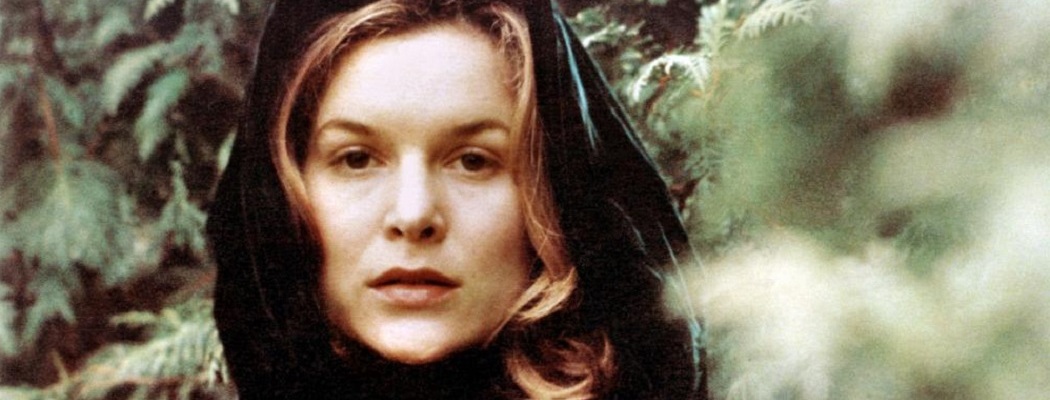

This was a great review. I love the movie and I had no idea any of the backstory here. Thank you so much for sharing. The book is probably one of my absolute favorites and I agree that there was probably no way anybody could make it into a movie that would be worthy of it. Glad I found your blog and this awesome review.
LikeLiked by 2 people
What an awesome comment! Thank you for the kind words. This is actually a friend’s blog; I’m just a contributor…but I hope to post more!
Considering how good the book is…I’m shocked no one has proposed a miniseries–that’s the only format that could do it justice.
Thanks again!
LikeLiked by 1 person
Well, I liked it! Despite all the tons of negativity. Dick Smith’s excellent melting corpses and Albert Whitlock’s art are a great combo. I’m 70. My dad worked for Disney as an artist from Steamboat Willie, Snow White and Fantasia etc, before WWll. He introduced me to horror/sci-fi flix back in the 50s. I’ve seen just about every film ever made. One thing I learned early on….”suspension of disbelief”. And, never trust anything critics say! Otherwise, you’d never have seen “Star Wars” and instead being bored to death watching “Academy Award” winners like “The English Patient” or worse. I haven’t seen Ghost Story since the 80s and it just popped up on Prime Video. I’m sure my son, who’s 36, and loves horror stuff too and hasn’t seen it yet will love it during this Halloween season. We love watching horror movies in our man-cave on our 75″ LG QNED85 with booming surround sound, beer 🍻 & popcorn 🍿
PS: loved the old coots, & Alice Krieg is sexually sinister and creepy. Had some g/fs like that…. thankfully, never worked out.
LikeLike
Here’s hoping someone will be inspired to recreate it as a mini-series!
LikeLike
[…] asthmatic 10-year-old Philip Hopkins (Lance Holcomb, Ghost Story) is anxiously awaiting the departure of his loving-but-suffocating mother, Ruth (Cornelia Sharpe, […]
LikeLike
[…] asthmatic 10-year-old Philip Hopkins (Lance Holcomb, Ghost Story) is anxiously awaiting the departure of his loving-but-suffocating mother, Ruth (Cornelia Sharpe, […]
LikeLike
The spooky house in this movie was filmed in my neck of the woods! It’s in Wilton, NY, and it actually still exists!
LikeLiked by 1 person
What’s the address of this house?
LikeLike
After a lot of sleuthing, I was able to locate the house on Smith Bridge Road! It was built in 1750 & still stands today as an exquisite, private residence!
LikeLike
🎶🎥🎞 I STILL LIKE “GHOSTSTORY”📽📺 🎶🎥🎞📽🎬⭐⭐⭐⭐⭐⭐
LikeLike
🎥🎞⭐It was a good movie sad and bitter sweet {the chowder society}made a real dumb decision they should have checked her pulse over again__I really loved eva/alma beautiful vintage masion. I would be thrilled if a remake hit the screen!!😎😲😊👍🏿⭐⭐⭐⭐📽🎬
LikeLike